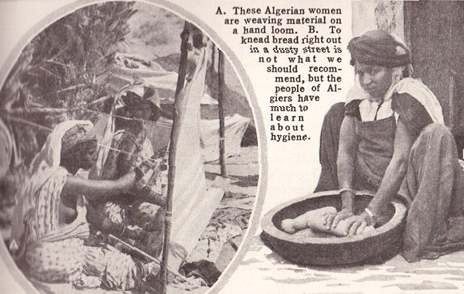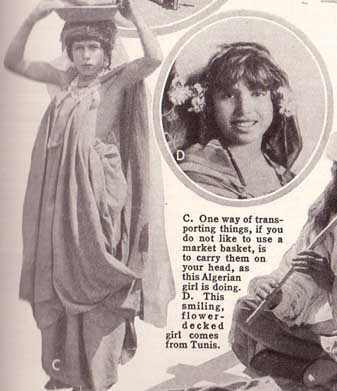
[With this post I start a new series dedicated to photographs in an “Orientalist” mode. In addition to Reading Orientalism (which is also the title of my last book), the creation of an imagined Orient is very much a pictorial voyeuristic voyage. In this series I focus on Western images of the Middle East and North Africa, both those that perpetuate stereotypes and those that chip away at the bias. Readers of the blog are welcome to send in images they have found and want to share.]
I start with images from a 1933 edition of Richards Cyclopedia, with 24 volumes published in New York by J. A. Richards, Inc and edited by Ernest Hunter Wright and Mary Heritage Wright. This is an unusual encyclopedia, arranged by topics in a more or less arbitrary order but replete with images. One of the articles is called “The Green Girdle of the Sahara” (vol 18, pp. 4631-4636). The subtitle is: “What Men Live Now along the Northern Strip of Africa, Where the Egyptians Started the Clock of History and Where Grim Carthage Used to Frown across the Sea at Rome?”
The article starts out by describing the Barbary coast and then adds this comment:
Although the Barbary Coast is not an Eastern, or oriental, country, lying as it does due south from Europe, it seems to visitors from Europe and America like a corner of the Orient. It has a religion out of the East, Mohammedanism (mô-hâm’êd-ân-îz’m). Among the farming peoples who make their living from its soil are many restless Jews and fierce Arabs, whose Eastern ways have been taken up by the native peoples. Thus the Berber of this small fertile strip treats his women folk as an oriental might treat them, and he has an oriental’s indifference to dirt. Yet the Berbers are cousins of the northern races, many of them having blue eyes and fair hair.
To be an Oriental outside the literal Orient, to have an indifference to dirt and to be a Mohammedan: such is the fate for the Berber in 1930’s stereotyping. The image above illustrates the sentiment of an Algerian woman who has “much to learn about hygiene.” Given the Islamic duty of ablutions before prayer and the long history of anti-bathing practice in Europe, this is a very narrow put-down indeed.

The picture immediately above shows both the hardship of being female (carrying market items on one’s head) and the beauty of the maid with flowers in her hair. Exotica über alles.
to be continued
Daniel Martin Varisco